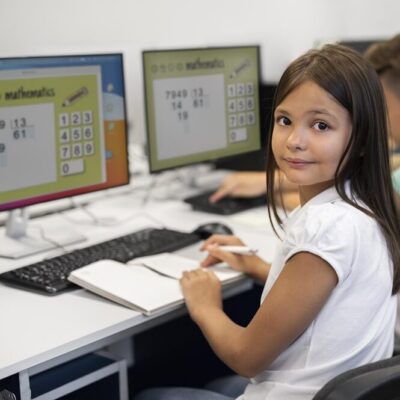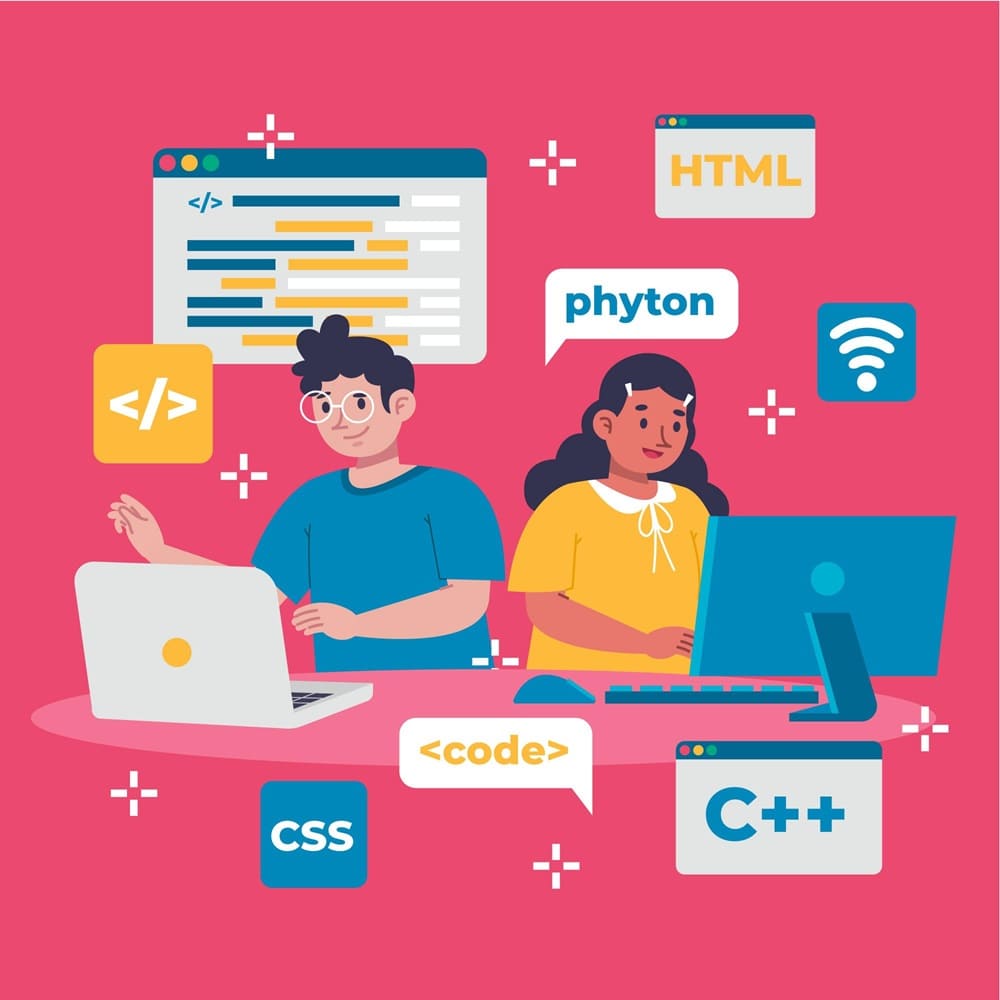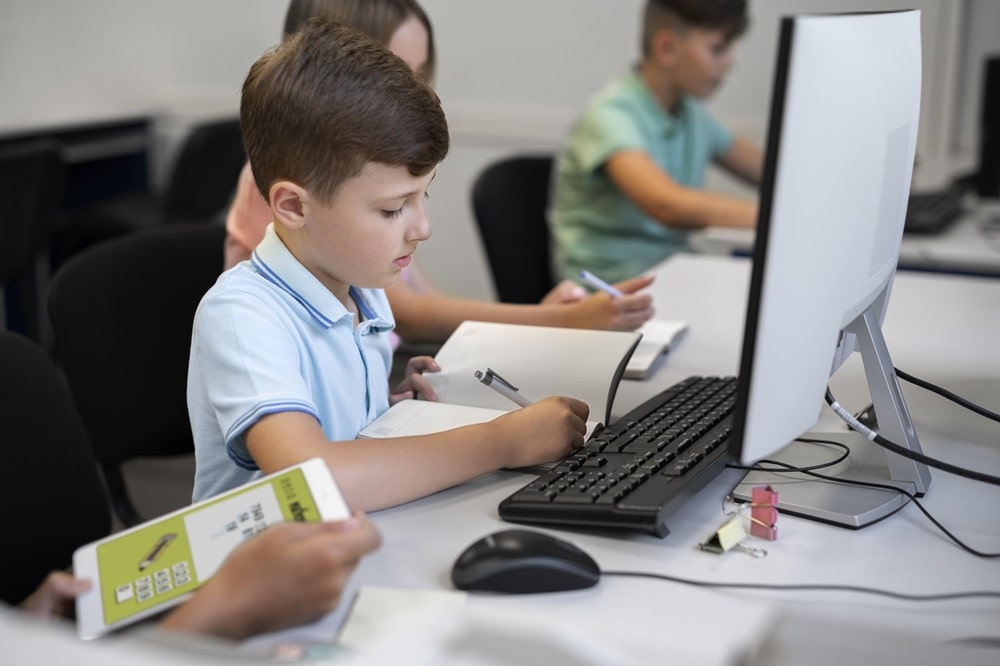
What is Coding for Kids: Exploring the Basics of Programming
What is coding for kids: For kids, coding is like giving instructions to a computer. Just like people talk to each other using languages, coding uses special languages computers understand.
It’s all about creating sets of instructions, or code, that tell the computer what to do. These instructions can be for simple things like showing text on a screen or for more complicated tasks like making games, animations, or controlling robots.
Learning to code helps kids understand how computers work and teaches them important skills like being creative, thinking logically, and solving problems. It lets them express their ideas digitally and bring them to life using code.
Kids learning to code use beginner-friendly languages and tools that make it fun and easy. They gain confidence by writing code and gradually learn programming concepts through tutorials, games, and projects.
Learning to code also prepares kids for the digital world they’ll grow up in by encouraging them to be innovative and curious learners.
Table of Contents

What is Coding for Kids and Why is Coding Important?
1. Understanding Coding for Kids:
Coding, or programming, is like giving instructions to a computer. It’s a way to communicate with machines using special languages that tell them what to do. For kids, learning to code means creating these instructions to make the computer perform tasks. These tasks can be simple, like showing text on a screen, or complex, like making a game or controlling a robot.
2. The Importance of Coding:
In today’s world, knowing how to code is very valuable. It’s like having a special skill that lets you create all sorts of exciting and useful things. Kids can make multimedia games that transport players to imaginary worlds, user-friendly mobile apps that help with daily tasks, and dynamic websites that serve as online stores.
3. Unlocking Creativity:
Learning to code allows kids to unleash their creativity and turn their ideas into real, digital projects. It’s a gateway to innovation, helping them solve complex problems, automate boring tasks, and even change entire industries.
4. Continuous Learning and Adaptation:
Coding teaches kids to keep learning and adapting, which is crucial in today’s fast-changing tech world. As they learn to code, they also develop important skills like critical thinking, problem-solving, and paying attention to details. They become more confident and persistent as they debug and improve their code.
5. Collaboration and Communication:
Coding often involves working with others on projects and contributing to open-source communities. This teamwork helps kids improve their communication and collaboration skills.
6. More Than Just a Technical Skill:
Coding is more than just knowing how to use a computer. It’s a creative tool that empowers kids to shape the digital world and make meaningful contributions to society. Whether they dream of becoming artists, or entrepreneurs, or simply want to explore new ideas, learning to code opens up endless possibilities for personal growth and creativity.
In summary, coding for kids is a powerful way to develop a wide range of skills while enabling them to create amazing digital projects and prepare for the future.
What is coding for kids: Different Kinds of Coding Languages

In computer programming, there are many languages designed for specific tasks and technological needs. These languages are essential for creating digital experiences, from exciting video games to dynamic websites and mobile apps.
1. Languages for Web Development:
HTML (Hypertext Markup Language): HTML is the foundation of web pages, providing the basic structure and layout.
CSS (Cascading Style Sheets): CSS enhances the visual appeal of web pages by controlling their look and design.
JavaScript: JavaScript adds dynamic features and interactivity to web pages, like form validation, animations, and real-time updates.
2. Languages for Mobile App Development:
Java: Java is a key language for developing Android apps. It offers reliable performance and works well with many devices.
Swift: Swift is the main language for creating iOS apps. Developed by Apple, it has a simple syntax and powerful features, making it perfect for designing smooth and user-friendly apps for Apple devices.
3. Languages for Game Development:
C++: C++ is widely used in game development for its high performance and flexibility. It helps create complex game mechanics and realistic physics simulations.
C#: C# is another popular language for game development, known for its ability to create immersive visual and audio experiences.
These programming languages are the building blocks for various technological advancements, enabling programmers to develop a wide range of digital experiences.

What is Coding for Kids and Why Learn to Code?
In today’s fast-changing digital world, teaching children to code is incredibly important. Like reading and writing, understanding and working with code is becoming a necessary skill. Technology touches every part of our lives, from communication to work and entertainment.
1. Preparing for the Future:
Technology will be a part of most future jobs. Learning to code early helps kids get ready for these jobs and navigate the digital world.
A strong foundation in coding opens many doors, whether they want to become software engineers, data analysts, designers, or entrepreneurs.
2. Critical Thinking and Problem-Solving:
Coding is about more than writing code; it’s about solving problems in a systematic and logical way.
Kids learn to break down complex problems into smaller, manageable parts and develop strategies to solve them.
This process enhances their critical thinking, adaptability, and creativity.
3. Creativity and Innovation:
Coding allows children to express their ideas and bring them to life.
Whether creating a game, an app, or a website, coding lets kids use their imagination in new and exciting ways.
It encourages experimentation, repetition, and creative thinking, fostering an innovative mindset that pushes the limits of what’s possible.
4. Empowerment and Self-Expression:
Teaching kids to code empowers them to take control of their digital lives, turning them from passive technology users into active creators.
It gives them the tools to customize their digital experiences, whether it’s creating an app to solve a local problem or designing a website to showcase their interests.
This sense of empowerment and independence boosts their confidence as they see their ideas come to life.
5. Digital Citizenship and Awareness:
In our connected world, kids need to understand how technology works and its impact on society.
Learning to code helps them grasp ethical issues related to technology, data security, and privacy.
It prepares them to be responsible digital citizens who can navigate the digital world safely and ethically.
By learning to code, children gain valuable skills that prepare them for the future, enhance their problem-solving abilities, foster creativity, and promote responsible digital citizenship. Coding is not just a technical skill but a tool for innovation and personal growth.

Examples of Coding for Kids
1. Making Characters Move with Scratch
Project: Make a cartoon character move across the screen.
How It Works: In Scratch, kids can use colorful blocks to give instructions to characters, called sprites. For example, they can make a sprite move when they press a key.
//What is coding for kids
when [space] key pressed
move 10 steps
//What is coding for kids
2. Creating a Maze Game with Blockly
Project: Build a game where a character navigates through a maze.
How It Works: Blockly is like Scratch, but with blocks that fit together. Kids can program the character to move through the maze using directional blocks.
//What is coding for kids
when run
repeat until goal
if path ahead
move forward
else
turn left
//What is coding for kids
3. Designing a Personal Webpage with HTML and CSS
Project: Create a webpage about themselves.
How It Works: With HTML, kids can structure the page, and with CSS, they can make it look nice. They might include their name, a picture, and some facts.
//What is coding for kids
<!DOCTYPE html>
<html>
<head>
<style>
body {
background-color: lightblue;
}
h1 {
color: navy;
}
p {
font-family: Arial;
font-size: 20px;
}
</style>
</head>
<body>
<h1>My Webpage</h1>
<p>Hi! My name is Sam. I like coding and playing games.</p>
<script>class RocketElementorAnimation{constructor(){this.deviceMode=document.createElement("span"),this.deviceMode.id="elementor-device-mode",this.deviceMode.setAttribute("class","elementor-screen-only"),document.body.appendChild(this.deviceMode)}_detectAnimations(){let t=getComputedStyle(this.deviceMode,":after").content.replace(/"/g,"");this.animationSettingKeys=this._listAnimationSettingsKeys(t),document.querySelectorAll(".elementor-invisible[data-settings]").forEach(t=>{const e=t.getBoundingClientRect();if(e.bottom>=0&&e.top<=window.innerHeight)try{this._animateElement(t)}catch(t){}})}_animateElement(t){const e=JSON.parse(t.dataset.settings),i=e._animation_delay||e.animation_delay||0,n=e[this.animationSettingKeys.find(t=>e[t])];if("none"===n)return void t.classList.remove("elementor-invisible");t.classList.remove(n),this.currentAnimation&&t.classList.remove(this.currentAnimation),this.currentAnimation=n;let s=setTimeout(()=>{t.classList.remove("elementor-invisible"),t.classList.add("animated",n),this._removeAnimationSettings(t,e)},i);window.addEventListener("rocket-startLoading",function(){clearTimeout(s)})}_listAnimationSettingsKeys(t="mobile"){const e=[""];switch(t){case"mobile":e.unshift("_mobile");case"tablet":e.unshift("_tablet");case"desktop":e.unshift("_desktop")}const i=[];return["animation","_animation"].forEach(t=>{e.forEach(e=>{i.push(t+e)})}),i}_removeAnimationSettings(t,e){this._listAnimationSettingsKeys().forEach(t=>delete e[t]),t.dataset.settings=JSON.stringify(e)}static run(){const t=new RocketElementorAnimation;requestAnimationFrame(t._detectAnimations.bind(t))}}document.addEventListener("DOMContentLoaded",RocketElementorAnimation.run);</script></body>
</html>
//What is coding for kids
4. Controlling a Robot with LEGO Mindstorms
Project: Make a robot move and turn.
How It Works: Using LEGO Mindstorms, kids can program a robot to follow commands. They can make it move forward, stop, and turn using blocks.
//What is coding for kids
when start
move forward for 2 seconds
stop
turn right for 1 second
//What is coding for kids
5. Writing an Interactive Story with Python
Project: Write a story where the reader chooses what happens.
How It Works: In Python, kids can write a story with different endings. They use if-else statements to change the story based on the reader’s choices.
//What is coding for kids
print("Welcome!")
choice = input("Do you want to go left or right? ")
if choice == "left":
print("You meet a friendly dragon!")
elif choice == "right":
print("You find a hidden treasure!")
else:
print("Invalid choice, try again.")
//What is coding for kids
These examples show how coding can be fun and creative for kids. It helps them learn problem-solving skills and understand technology better.
Conclusion: what is coding for kids
In summary, learning to code is more than just a technical skill. It’s like learning to read and write, giving kids important tools they need to do well in today’s digital world.
1. More Than a Skill:
Coding is not just about writing code; it’s a basic skill that helps kids understand and interact with technology in meaningful ways.
2. Critical Thinking:
Kids learn to think logically and solve problems. They figure out how to break down big challenges into smaller steps, which helps them in many areas of life.
3. Creativity:
Coding lets kids use their imagination to create games, apps, and websites. They can turn their ideas into real projects, making learning fun and exciting.
4. Problem-Solving:
Through coding, children learn to find solutions to problems. This helps them become more resourceful and resilient.
5. Self-Expression and Empowerment:
Coding empowers kids to create their digital content. They move from being just users of technology to being creators, which builds confidence and independence.
6. Digital Citizenship:
Learning to code helps kids understand how technology affects society. They learn about the ethical use of technology, data privacy, and security, preparing them to be responsible digital citizens.
By learning to code, kids gain essential skills that help them succeed in the 21st century. They learn to think critically, solve problems, and express themselves creatively. Coding also helps them understand their role in the digital world, empowering them to shape the future of technology and society.
FAQs : What is coding for kids
1. What is coding for kids?
Coding for kids means teaching children how to give instructions to a computer. These instructions, called codes, tell the computer what to do.
2. Why is coding important for children?
Coding helps children think critically, solve problems, be creative, and reason logically. These skills are very important in today’s digital world.
3. At what age can children start learning to code?
Children can start learning the basics of coding as early as 5 or 6 years old. There are special tools and resources designed just for young kids.
4. What programming languages are best for kids to learn?
Some good beginner programming languages for kids are Scratch, Blockly, Python, and JavaScript. These languages are easy to understand and use.
5. How can coding benefit a child’s future?
Learning to code can open up many job opportunities in the future. It also helps kids develop problem-solving skills and encourages continuous learning.
6. What types of projects can kids create with coding?
Kids can use coding to create games, animations, websites, mobile apps, and even simple robots or interactive stories.
7. Are there any online resources or tools for kids to learn coding?
Yes, many online platforms like Code.org, Scratch, Tynker, and Khan Academy offer fun and interactive coding lessons and projects for kids.
8. Do children need to be good at math to learn coding?
While knowing some basic math can be helpful, coding mainly requires logical thinking and problem-solving skills. Kids can develop these skills with practice.
9. Can coding be a fun activity for kids?
Definitely! Coding can be made fun with interactive games, creative projects, and coding challenges that make learning enjoyable for kids.
10. How can parents support their children in learning to code?
Parents can help by providing access to coding resources, encouraging their kids to try coding projects, and learning alongside them to create a positive and supportive learning environment.
